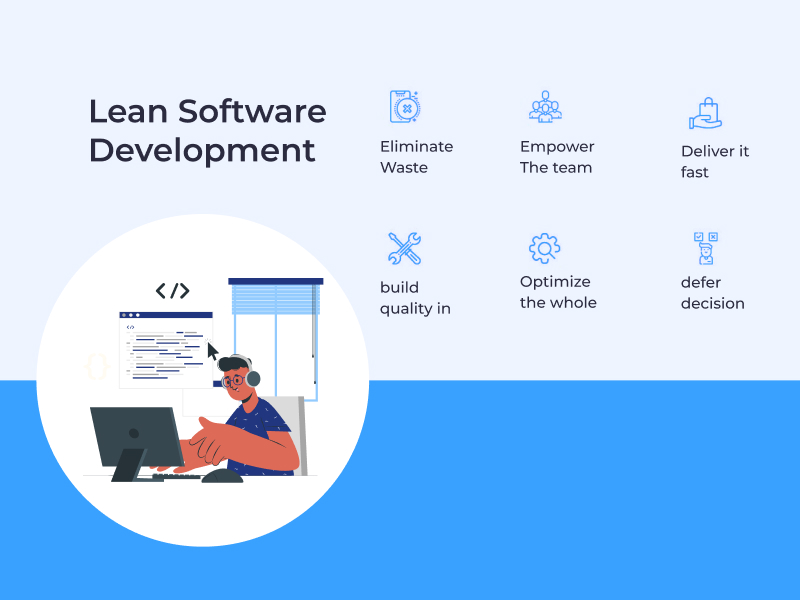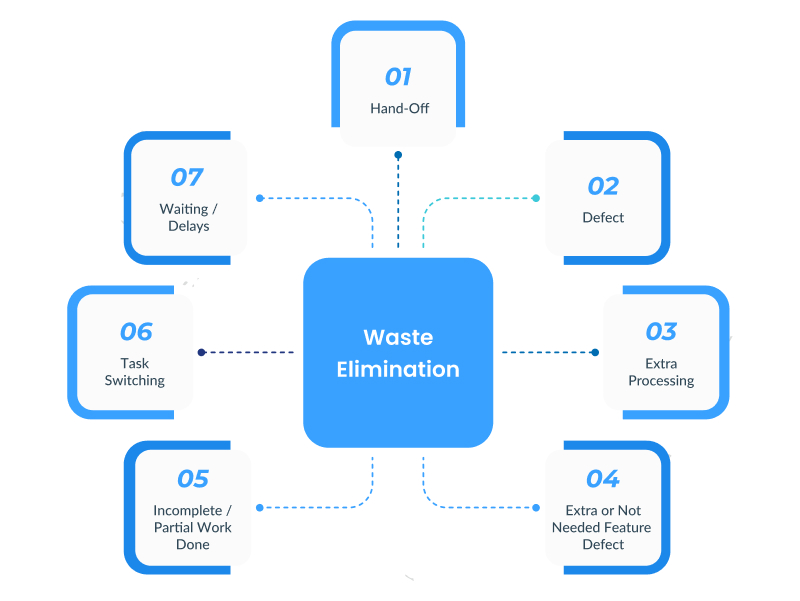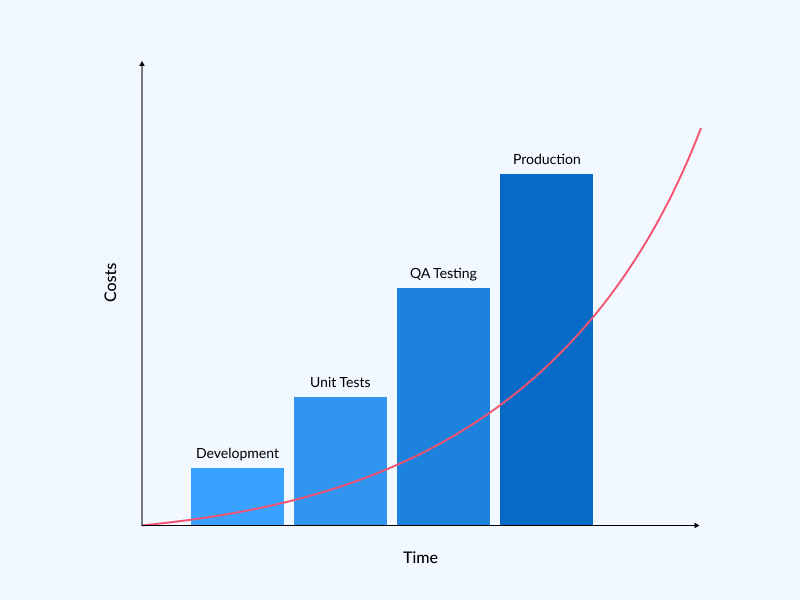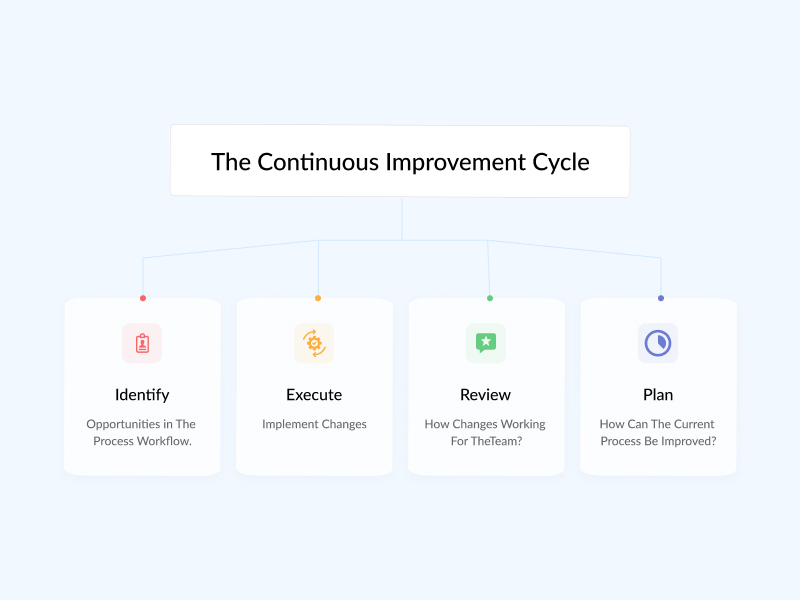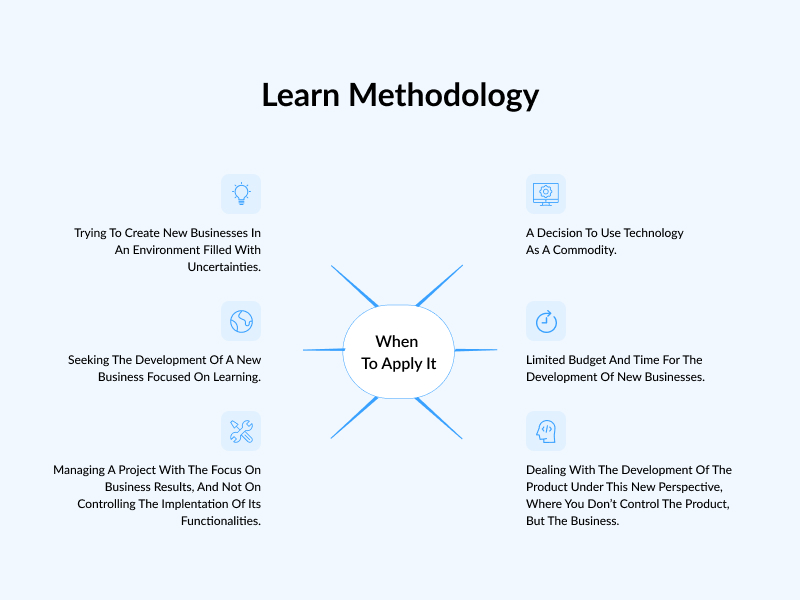In the era of software development, “revolutions” appear almost every month. Some fade away over time, while others take the lead and become mainstream.
One such revolution is called Lean Software Development Methodology, which has been around for a few years.
The number of companies that switched to Lean software development is still limited, but it’s growing fast and spreading like wildfire.
If you ask yourself, “What is Lean, and why should we care about it?” – you have come to the right place.
In this post, we will cover all the significant topics, including-
- Lean software development principles
- Standard Lean Practices
- The benefits and drawbacks of Lean
- And how to implement this methodology
But, first things first, let us start with the definition.
Table of Contents
What is Lean Software Development?
Lean software development is an adaptable process for creating and sustaining successful products. It follows the Lean Manufacturing approach principles developed in Toyota in the 1940s. Most automobile companies like Ford and Nissan practice this methodology.
It’s a ‘value-driven approach to handle software development projects which provide the best possible solution to meet customer needs and run a sustainable business. It helps organizations build new features and functionality with less time, money, resources, etc.
Also Read: Automation in Software Development- A New Stream of Revolution
What are The 7 Lean Software Development Principles?
Understanding the seven lean software development principles helps in decision-making. You can apply all of them in your software product development process:
1. Waste Elimination
It is one of the essential things your production partner must focus on. Here, waste refers to things that don’t significantly affect the quality of the developmental strategies and the end products. Ensure that your hired software developers fix any repetition or irrelevant items in the software development process.
To be precise, here are a few things you can resolve:
- Unwanted feature code
- Code errors
- Vague demands
- More steps in the logs than can be completed
- Delays in the engineering system
- Inadequate communication
- Issues with the quality
- Data replication
2. Building Quality In
It’s not enough to eliminate waste as the waste might go undetected. It can later spread in your team and affect other parts of your development process. The best way to handle this is through building quality in:
- Asking questions about the product
- Inspecting code for any defects
- Maintaining a clean code
- Maintaining a sustainable pace for the team members
- Assessing any risks in advance
- Encouraging Knowledge sharing within the team
Lean development is all about quality. It’s not only about building applications of ultimate quality but about creating a process that will improve software quality on an ongoing basis. Its main idea is to prevent any issues and fix them as soon as they’re spotted.
Developers will develop more reliable software in the long run. As a result, quality assurance processes will become much easier to handle and maintain.
Besides, Lean methodologies work great for project management since all documentation is concise and straightforward. This way, the entire workflow becomes much easier to handle and more sustainable in the long run.
Hire Software Developers For Advanced App Solutions. Develop feature-rich software and applications with our software developers.
3. Amplifying Knowledge
Lean programming also enhances team spirit and togetherness and automates repetitive work processes. Thus, it spares engineers’ time to disseminate their experiences to each other.
Lean software development methodology focuses on quality from day one. As a result, teams can build great applications that will last for years. It means your customers won’t be affected by any bugs or errors.
It even offers excellent tools for managers to plan the team’s workflow. Each person’s capacity is considered, so engineers won’t be overloaded with tasks.
4. Delaying Commitment
Not locking into a group of technologies and choices means that the lean methodology is flexible. It allows working with networking components, databases, and frameworks. There will be no problems if an engineer decides to use Spring for some part of the code and Java EE 7 for another. They can do so without hassle, as Lean assumes such liberty is fundamental.
It is worth adding that the business only agrees to pay for the working product. So the project will be over only when all the tried-and-tested options have been implemented successfully. With Lean, there are no wasted resources.
5. Fast Delivery
Lean is speedy. It allows saving months by avoiding things that are not critical, focusing on essentials only.
Businesses can perform several stages simultaneously. So there’s no need to waste time on long preparations or interim evaluations. It will speed up the process if all the team members have worked together.
Lean methodology is also lightweight, so any project will get a kick-start with it. That way, it is possible to deliver the minimum viable product (MVP) at an early stage while the need for further development is still being analyzed.
Lean development methodology may sometimes be risky for the business since it can mean the product will not have all its essential features implemented. Hence, using the method for projects where an MVP is sufficient is good.
6. Respecting the Team
Lean development takes into account that people are more important than tools. The team must not be micromanaged, nor there be any strict controls on the workflow’s individual. It is better to trust engineers and learn from their own mistakes.
Lean encourages excellent communication within the team, so each member’s opinion can significantly influence the final result. It has great potential for team building. Here all members are involved in planning the workflow and deciding the next development steps.
This way, engineers can get to know each other better and work more efficiently.
Lean development is more demanding for the team’s motivation since engineers must be left alone to work with whatever tools they want.
7. Optimizing the Complete Value Stream
Lean methodology is a very flexible tool that can optimize various processes. In the case of software development, it covers everything from communication with stakeholders to project management and improvement of code quality.
Lean development also encourages testing as many times as possible – from unit tests within an application down to end-to-end tests responsible for checking the work of an entire application as a whole.
The lean methodology can be applied to any business, as it is not followed slavishly. Its measures may vary depending on the requirements of every given project.
Lean makes developers look at their work differently, teaching them to consider all the possible risks and problems during development. By doing that, lean methodologies make the software more reliable and sustainable in the long run.
What are Lean Practices?
Now that you know the Lean principles, it’s time to peek at some lean practices.
Value Stream Mapping (VSM)
You can use this Lean practice to identify the steps necessary to complete the project, the critical paths, where delays tend to happen, and more. This way, you can set goals for improvement in every stage of work.
Set-based Design (SBD)
This lean practice considers the entire business process and not just single features. Instead of implementing different characteristics, you should create one feature set addressing multiple cases.
Pull-systems
It is used in manufacturing and production. It is based on only producing what is demanded and no more. You can start this process by identifying each step in your workflow, making a list of tools and materials needed for them, and building the exact number of items required to keep your inventory low.
What are the Strengths and Weaknesses of Lean Software Development?
5 Strengths of Lean Software Development
- Lean is lightweight and agile, focusing on a project’s essentials. This way, it cuts out anything that does not directly affect the final work result. That means that all unnecessary meetings and documentation are omitted – which can significantly cut down on time and resources needed for a specific task.
- Lean also makes for excellent communication within the team, so each member’s opinion can significantly influence the final result. And since engineers can get to know each other better and work more efficiently together, this process may become a great team-building experience.
- Lean encourages testing as often as possible – from unit tests within an application down to end-to-end tests responsible for checking the work of an entire application. This way, lean methodologies make the software more reliable and sustainable in the long run.
- Having all team members involved in planning the workflow and deciding the next development steps makes it easier for engineers to get to know each other better. It is another excellent team-building experience, where this way they can work more efficiently together.
- Lean methodology is a very flexible tool that can optimize various processes – from communication with stakeholders to project management and improvement of code quality.
Hire Software Developers For Advanced App Solutions. Develop feature-rich software and applications with our software developers.
5 Weaknesses of Lean Software Development
- Lean requires high motivation from the team, as they have to work self-sufficiently without strict workflow controls. Engineer’s mistakes will thus be their responsibility – this way, it is difficult to learn from them later when no controls are in place.
- The lean methodology is risky, as instead of finding and fixing problems earlier, it encourages taking risks and solving problems even before they arise. This way, the team may be taking an unknown threat, potentially resulting in damages.
- Lean requires all team members to be involved in the project, which can be challenging if team members are hired or fired at any time.
- Lean often requires a high level of education for its tools and practices to be used efficiently. If one member does not have this Knowledge, it may slow down the entire process. So, Lean methodology is usually applicable across large companies.
- Lean can increase the risk of quality problems as it does not focus on testing and addressing mistakes before moving to the next stage of development.
How to Apply Lean in the Software Development Lifecycle?
It is possible to deploy Lean principles in each production stage. Let’s find out how the principles suit each step of software development:
#1: Concept Phase
Lean encourages doing business with concrete requirements. This way, the customer learns the final product earlier, eliminating the risk of working on unnecessary things.
#2: Requirements Phase
Lean improves this phase by focusing on reducing waste and maximizing value through early identification of risks. It allows for better precise estimations and makes it easier to determine if we can deliver them in time.
#3: Design Phase
Lean recommends doing things right first by improving quality and removing waste. This way, engineers will not need to fix problems that could have been prevented, reducing the testing time and effort needed to fix bugs at a later stage of development.
#4: Development/Coding Phase
The Lean methodology helps engineers by pushing them to continuously improve their work and decrease bugs in the code. This way, Lean allows teams to work more efficiently without worrying about mistakes made later in development.
#5: Testing Phase
The lean approach to testing is to find bugs as soon as possible. You can focus on reducing waste and validating assumptions made earlier through regular checkups.
#6: Deployment Phase
Lean principles encourage customers to get involved at any development step to ensure that they are getting the features that matter the most. This way, it will be simpler for engineers to prioritize the tasks and provide value faster.
Read Also: Top 12 Risks in Software Development and How to Mitigate Them?
Parting Thoughts
Software development is a complicated process that can be made easier with lean principles. This way, teams can better use the resources and offer higher quality for customers.
Besides, Lean satisfies customers’ needs by ensuring they are involved in the project from start to finish. Hence, there are no uncertainties or surprises in the end. If you are also thinking of implementing this method, I would suggest you hire a software outsourcing company. Why? Because deploying such an approach requires efficiency and expertise.
Have any other doubts? Mention them in the comment section below!
Frequently Asked Questions
What is the Lean model?
The lean model is a framework for continuous improvement and uses five core principles: value, waste, process, people, and tools. This method provides customer value by solving issues early in the production cycle.
How can Lean be applied in project management?
Lean encourages teams to work together and remove waste from the process. This way, teams can work more effectively and deliver better customer software.
How long does it take to implement Lean in a team?
It depends on how deeply you wish to implement lean principles. But if you focus on applying just one principle at a time, it should not take too long before seeing the first results.
What is the difference between Lean and Agile?
Both lean and agile encourage working towards building better software for customers. Lean applies continuous improvement by removing waste from the process. On the other hand, agile is a set of principles to develop software iteratively and deliver value increments.
Lean vs Scrum – What are the differences?
Lean was developed as an extension to lean manufacturing but can be applied in any situation where improvement is possible. On the other hand, Scrum is just one of many agile frameworks that can be used to manage projects.
Get in Touch with Pixelcrayons Professionals for all your project needs. We send estimates within 24 hours.


